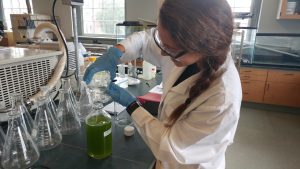The majority of commercial aquaculture facilities utilize fish feeds composed of fish oil and fishmeal sourced from marine catches or plant-based ingredients produced via industrial agriculture practices. Researchers have shown that microalgae are an attractive alternative to unsustainable forage fish-based and crop plant-based aquafeed ingredients. However, if microalgae production relies on inorganic fertilizers, then the unsustainable sourcing of inputs has not been improved, but rather shifted to another sustainability.
 To address this issue, we have adopted a systems approach (pdf) to the food-energy-water nexus of aquafeed production. Our latest work focuses on the sourcing of upcycled waste nutrients in order to displace some or all of the inorganic nutrients for cultivating microalgae on a commercial scale for aquafeed ingredients. We are focusing on brewery wastewater as a promising potential nutrient waste stream because it is widely available, contains dissolved forms of nitrogen and phosphorus, and is largely free of concerning pathogens or contaminants. Utilizing brewery wastewater for microalgae cultivation also has the potential to reduce energy inputs needed for standard domestic wastewater treatment, as well as energy embedded in inorganic microalgae fertilizers.
To address this issue, we have adopted a systems approach (pdf) to the food-energy-water nexus of aquafeed production. Our latest work focuses on the sourcing of upcycled waste nutrients in order to displace some or all of the inorganic nutrients for cultivating microalgae on a commercial scale for aquafeed ingredients. We are focusing on brewery wastewater as a promising potential nutrient waste stream because it is widely available, contains dissolved forms of nitrogen and phosphorus, and is largely free of concerning pathogens or contaminants. Utilizing brewery wastewater for microalgae cultivation also has the potential to reduce energy inputs needed for standard domestic wastewater treatment, as well as energy embedded in inorganic microalgae fertilizers.
We have reviewed the literature on brewery wastewater characteristics and composition, and collected wastewater samples from two local breweries, Harpoon Brewery in Windsor, Vermont, and Norwich Inn Brewery in Norwich, Vermont. The next steps in this project will involve 1) obtaining further brewery wastewater samples from local breweries, and 2) conducting preliminary growth experiments of Nannochloropsis oculata microalgae in brewery wastewater. We are also developing a larger research effort in partnership with algal research facilities and breweries in Arizona.


